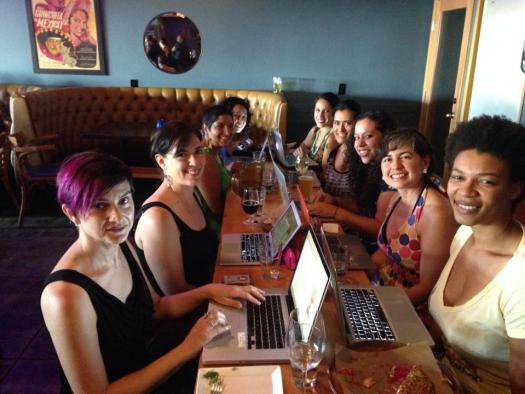By Xochitl-Julisa Bermejo
In honor of National Poetry Month, Women Who Submit is hosting a Poetry Submission Blitz on April 9, 2017 from 12pm-3pm at the Arts District Brewing Company. A submission blitz is a call to writers to submit their well-crafted and cared for work en masse to tier one literary journals that historically have shown gender disparities in their publications. A submission blitz is a call to action.
After the first VIDA Count was published in 2009 illustrating the dearth of women’s voices in tier one publications, members of VIDA, Women in Literary Arts, began asking the editors of these journals why they thought the numbers were unbalanced. The most common answer was women don’t submit as often as men. In response, Women Who Submit and the monthly submission party was created in 2011 to support women and nonbinary writers in submitting their work for publication in order to raise the number of such voices coming across editors’ desks. Every September, Women Who Submit celebrates another year of organizing with an annual all-genre Submission Blitz. Though we cannot know if one of our writers will have work accepted by these journals, it is a practice in submission and a practice in solidarity.

To celebrate National Poetry Month, WWS is hosting a Poetry Submission Blitz targeting the following six tier one journals: The Nation, The New Yorker, Believer, Three Penny Review, A Public Space, and New England Review. All six journals publish poetry, have current open calls, and have exhibited gender disparity according to the VIDA Count. Set your sights on one or six, the option is yours, but don’t feel limited to these targets. Here is full list of open calls for April and May in all genres from Entropy.
On Sunday, you can find us on the patio of Arts District Brewing Company from 12pm-3pm. Bring your poetry, laptops, and your thirst! Every time a writer presses send, we will clink pints and cheer to their success!
For inspiration, I invited five poetry editors–Raina Leon, Editor-in-Chief at Acentos Review, Michelle Detorie, Poetry Editor at Entropy, Cati Porter, Editor-in-Chief at Poemeleon, Casandra Lopez, Editor-in-Chief at As/Us, and Kelly Davio, Poetry Editor and Co-Founder at Tahoma Literary Review—to answer five questions on submission. Here is what they had to say.
Why is it a good idea for poets to submit their work?
Raina Leon: There are those that would manipulate time by erasing those within it. History, we have learned, is made by the conquerors, but what if all peoples, including those who resist oppression and even resist the language of war, can make their temporal presence known through literary work? This is not a philosophical exercise. It is truth. We must tell our stories, persist over the ripples of time through the making of history, through the publishing of our words in the world.
Michelle Detorie: Sending your work “out there” changes it, and it changes you. As the writer, preparing one’s work for submission necessarily requires you to wonder about it in a new way. In writing instruction, some folks like to discuss texts as “writer-based” or “reader-based” — which, crudely, could be described as writing that we do for ourselves (to-do lists, diary entries) and the writing we do to intentionally communicate something specific to a reader. Sending one’s work out gets one into an active space of imagining a reader, which is always useful.
Cati Porter: Submitting your work is a way of ensuring that your voice has the opportunity to be heard, but it is is important to remember that it is one path among many.
Casandra Lopez: Most poets are not going to have the opportunity to be published unless they submit to journals. I see it as part of one’s engagement with the literary community. Ideally, a poet would be reading various journals and their submissions requirements before submitting. Once you are published it is a way to share your work and build connections with other writers and readers of literary journals.
What is your view of rejection?
Raina Leon: Rejection from a particular journal means only that the submitted work was not read by right audience. It is a challenge to rewrite and review, to resubmit. The audience for one’s work is out there, and if not, then the pile of rejections is a call to start one’s own venue and welcome the work of others who have similarly been rejected. Maybe the world isn’t ready for what you do; maybe it should be. Maybe you are a part of a community on the verge.
Michelle Detorie: I think “rejection” is kind of fictitious. I consider my editorial role to be more curatorial — that of making and holding a type of space, and having that space be “public”/available to others. But of course if I’m the one selecting the work for that space, there is going to be some reflection of my taste/values/politics, right? And that is never neutral. So I feel like “acceptance” and “rejection” don’t really work. Publications are like weathers or habitats: there are so many different ways into their energies. If one’s work doesn’t ‘“land” somewhere, it just means that it gets to keep going.
Cati Porter: Rejection means you haven’t yet found the right home for your work. It is not a reflection of the quality of the work. More likely, it is simply a matter of editorial preference, or the mood of the editor, or what they ate for breakfast.
Casandra Lopez: As a writer I try not to let it weigh too heavily on me because I understand as an editor that the process is subjective. A poem may just not be the right fit at one journal, but another editor and a different journal might love it, which is why it is important to submit to a variety of publications. I do think it can be helpful to examine the trends in one’s responses to help guide revision.
As an editor, what is one thing you would like poets to understand about the publication process?
Raina Leon: Two things: read the submission guidelines and read the journal. Those guidelines are crafted with a purpose. They share the criteria by which editors review submissions. Following the guidelines is a significant help to editors who rely on the formatting of accepted submissions to craft a strong issue. Reading the journal demonstrates that you are interested in being a part of that published community.
Michelle Detorie: For me personally, I consider publishing to be an opportunity to build and support community. So I guess I would say that it’s important to be active in writing communities as a way of supporting one’s engagement with the publication process. This means showing up for stuff, reading and sharing people’s work, participating in discussions, and actively working to broaden your perspective and get a sense of what’s going on in different publishing communities. There are new ones every day! It’s so rad!
Cati Porter: That editors are people too, and that editing is largely an unpaid labor of love, so when you feel frustrated about wait times or a terse response, it is more likely a reflection of how the editor’s day is going overall and has nothing at all to do with you or your work.
Casandra Lopez: They should understand that it is a process that varies for different publications. Sometimes the production schedule will be quick and there might be multiple people working on an issue, while other times the process can take a lot longer. At As/Us we have a small group of volunteers who are involved in the process and before that it was only myself, my co-founder and the production editor who were responsible for the production of each issue. It is always great and helps production when a contributor responds promptly to emails and requests. It can sometimes slow down production and cause more work for the editors when contributors take a long time to respond to requests.
Kelly Davio: I’d like poets to know that the publication process isn’t just about having a poem come out in one journal and then moving on to another; good editors care about developing long-standing editorial relationships with the writers whom we publish. I want to hear writers’ good news so that I can help promote their books when they have full collections out, I want to know about their readings so that I can attend, and I want to publish more of their work in the future.
What does the “slush pile” mean to you?
Raina Leon: This is supposed to mean a collection of unsolicited manuscripts. For The Acentos Review, just about all submissions are unsolicited, so for me, those who submit are literary community members who have shared the gift of their art and the trust in my regarding it with care.
Michelle Detorie: Ha. For me it means that our culture doesn’t value creativity enough. I don’t know if I have anything else to really say about that.
Cati Porter: It means all the hard-working wonderful poets out there who are not getting special treatment because of their previous publication history.
Casandra Lopez: Slush typically refers to general non-solicited submissions a journal receives. At As/Us we don’t tend to refer to our submissions as slush because we are a small journal that focuses on community and so we tend to have some connection to those that submit to our calls. We do solicit writers, but we often publish works that we receive through our general submissions.
Kelly Davio: Without the slush pile, my journal wouldn’t exist! I have a no-solicitation policy for work at Tahoma Literary Review; everything that I print is sourced from the “slush,” or the open submission queue. Personally, I think that the practice of soliciting work for publication results in only a limited group of writers—with a limited range of aesthetics—finding representation in literary journals. Selecting work exclusively from the slush allows me to discover new-to-me poets and support the work of emerging artists.
What does “tier one” mean to you, and how much should new and emerging poets be concerned with publication tiers?
Raina Leon: Tier one, I suppose, is associated with the journals that are at the top in a field. What are the criteria by which publications are assessed? And by whom? I have other questions that I would like to pose to new and emerging poets: what is the aim of your work? Where do you want to be read and why? If you are studying with a formal education program, like an MFA, and your end goal is to be a university professor, you might want your work published within journals and presses that are partnered with or supported by universities. If your goal is to have your work exist within a particular community, then what are the presses and journals that directly connect with that community? You should also do your research into the journal/press and the visions behind those publication spaces. You should know the community in which your work will exist and be proud of being a part of that community.
Michelle Detorie: To be honest, the term “tier one” kind of makes my skin crawl and also makes me feel vaguely anxious and a little terrible, so I personally wouldn’t advocate investing in a publication just because it’s “tier one.”
I don’t mean to diminish the pressures we all feel to be “successful.” That’s definitely something that’s deep in our culture and one kind of has to muck their way through it, and it usually kind of sucks because it has to do with interfacing with all this stuff that is heavy with hierarchies and tastes and received traditions, and those things all have a politics. So I would say pay attention to that, and question it. And also, pay attention to this struggle within yourself to be “accepted,” and feel empowered to question it and be curious about it. And if you can’t find a space that feels right for your work, maybe it’s because that space needs to be created. There are always new communities being called into being. Which is all to say, instead of thinking about “tiers,” try thinking about “communities.”
Cati Porter: Tier one means that the journal has a large subscription base, and a reputation (for better or worse) to uphold, and maybe — maybe? — getting paid. It can also mean something cliquish, hard if not impossible to break into, and most certainly not worth getting your heart broken over. Emerging poets especially should not concern themselves with publication tiers; rather, they should focus on finding publication venues whose vision and mission is in line with their own, whatever that may be.
Casandra Lopez: When I submit to journals or compare As/Us to other journals I don’t necessarily think of tiers, but I do think that there are those in the literary community who categorize journals by tiers according to various aspects including the acceptance rate. As a writer and reader of literary journals I don’t necessarily find the idea of tiers helpful, instead I consider the fit of the journal. I also have my own dream publications that is based on if I feel a connection to a journal’s mission, how much I enjoy the work they have previously published and their aesthetics. I’d suggest new and emerging poets create their own list of dream publications based on their own values and keep on submitting to them.
Kelly Davio: This is a question I have to answer as both a submitting writer and an editor, because my experiences on both sides of the desk have shaped my thinking about this issue. “Tier one” means very little to me at this point. I no longer calculate the worth of a journal based on how many pieces it’s had listed as honorable mentions in the back of one anthology or another, or on what some guy says on some blog somewhere about which journals are the “best.” What matters most to me is how well, how transparently, and how professionally a journal is run. How does the publication treat its writers? Are the poets getting paid (and if not, what are other upsides to publishing in that venue)? Are the journal’s policies writer-friendly (i.e., are the turnaround times quick, are simultaneous subs allowed, and are the editors communicative)? Is the journal actively promoting its writers and its issues? Is the selection process transparent? As a writer and an editor, I’m far more invested in having a positive, productive publishing experience than I am in adding credits to my bio.
 Xochitl-Julisa Bermejo is the author of Posada: Offerings of Witness and Refuge (Sundress Publications 2016), a 2016-2017 Steinbeck fellow and former Poets & Writers California Writers Exchange winner. She has work published in Acentos Review, CALYX, crazyhorse, and The James Franco Review and is a cofounder of Women Who Submit.
Xochitl-Julisa Bermejo is the author of Posada: Offerings of Witness and Refuge (Sundress Publications 2016), a 2016-2017 Steinbeck fellow and former Poets & Writers California Writers Exchange winner. She has work published in Acentos Review, CALYX, crazyhorse, and The James Franco Review and is a cofounder of Women Who Submit.

